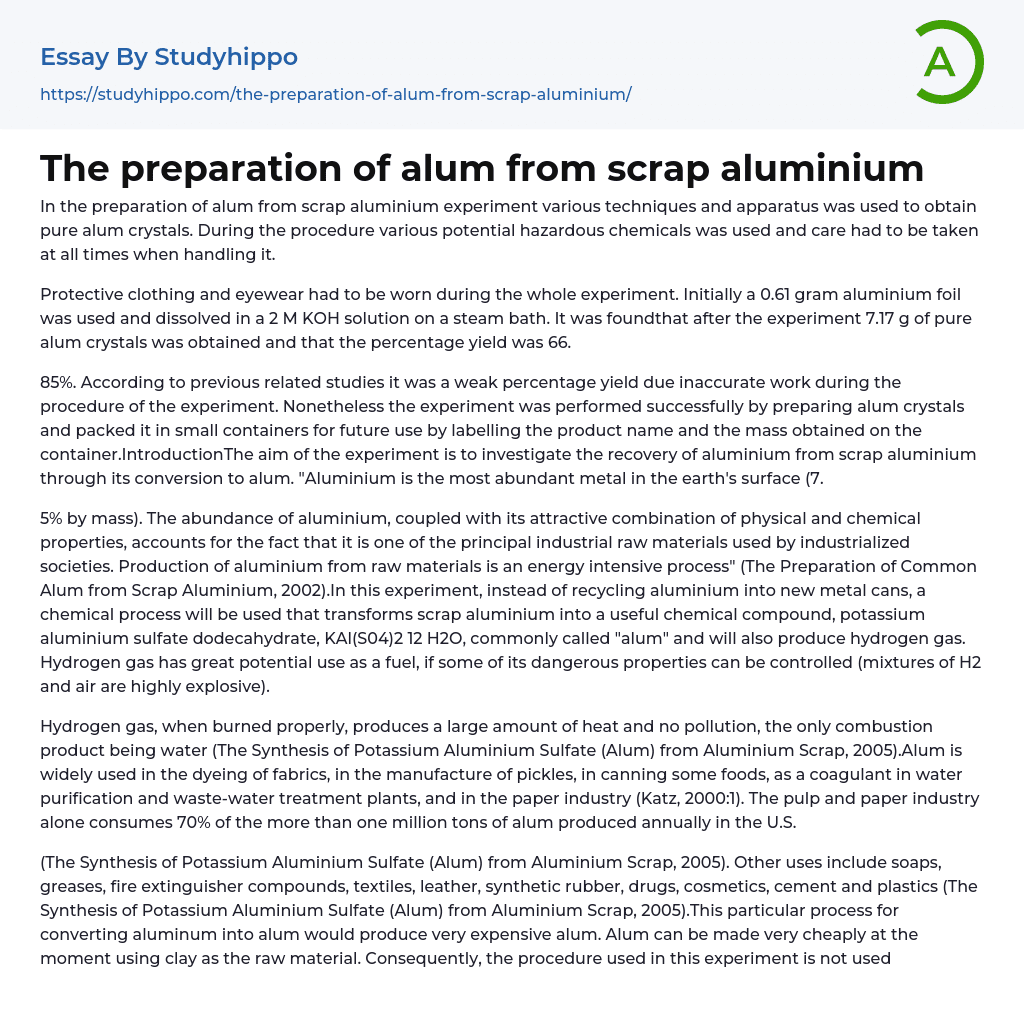In the preparation of alum from scrap aluminium experiment various techniques and apparatus was used to obtain pure alum crystals. During the procedure various potential hazardous chemicals was used and care had to be taken at all times when handling it.
Protective clothing and eyewear had to be worn during the whole experiment. Initially a 0.61 gram aluminium foil was used and dissolved in a 2 M KOH solution on a steam bath. It was foundthat after the experiment 7.17 g of pure alum crystals was obtained and that the percentage yield was 66.
85%. According to previous related studies it was a weak percentage yield due inaccurate work during the procedure of the experiment. Nonetheless the experiment was performed successfully by preparing alum crystals and packed it in small containers for future use by labelling the product name and the mass obtained on the containe
...r.IntroductionThe aim of the experiment is to investigate the recovery of aluminium from scrap aluminium through its conversion to alum. "Aluminium is the most abundant metal in the earth's surface (7.
5% by mass). The abundance of aluminium, coupled with its attractive combination of physical and chemical properties, accounts for the fact that it is one of the principal industrial raw materials used by industrialized societies. Production of aluminium from raw materials is an energy intensive process" (The Preparation of Common Alum from Scrap Aluminium, 2002).In this experiment, instead of recycling aluminium into new metal cans, a chemical process will be used that transforms scrap aluminium into a useful chemical compound, potassium aluminium sulfate dodecahydrate, KAl(S04)2 12 H2O, commonly called "alum" and will also produce hydrogen gas. Hydrogen gas has great potential
use as a fuel, if some of its dangerous properties can be controlled (mixtures of H2 and air are highly explosive).
Hydrogen gas, when burned properly, produces a large amount of heat and no pollution, the only combustion product being water (The Synthesis of Potassium Aluminium Sulfate (Alum) from Aluminium Scrap, 2005).Alum is widely used in the dyeing of fabrics, in the manufacture of pickles, in canning some foods, as a coagulant in water purification and waste-water treatment plants, and in the paper industry (Katz, 2000:1). The pulp and paper industry alone consumes 70% of the more than one million tons of alum produced annually in the U.S.
(The Synthesis of Potassium Aluminium Sulfate (Alum) from Aluminium Scrap, 2005). Other uses include soaps, greases, fire extinguisher compounds, textiles, leather, synthetic rubber, drugs, cosmetics, cement and plastics (The Synthesis of Potassium Aluminium Sulfate (Alum) from Aluminium Scrap, 2005).This particular process for converting aluminum into alum would produce very expensive alum. Alum can be made very cheaply at the moment using clay as the raw material. Consequently, the procedure used in this experiment is not used as an industrial method for recycling aluminum (The Synthesis of Potassium Aluminium Sulfate (Alum) from Aluminium Scrap, 2005).
Although aluminum metal sits well above hydrogen in the activity series, it reacts only slowly with dilute acids because a thin coating of aluminum oxide protects the metal surface. Aluminum reacts with alkaline solutions (figure 1) to produce hydrogen because the excess hydroxide ion first attacks the tough Al2O3 layer so the metal can react (Synthesis of Alum from Aluminium, 2001). Aluminum converts to the tetrahydroxoaluminate ion Al (OH)4-. Slow addition of acid to
a solution of this ion causes the precipitation of solid Al (OH)3 followed by the dissolving of the precipitate to form the aluminum ion Al3+. The solid Al(OH)3 will also dissolve in excess base due to formation of Al(OH)4-.
We call a hydroxide that can react with either acids or bases amphoteric (Synthesis of Alum from Aluminium, 2001).
- Accounting essays
- Marketing essays
- Automation essays
- Business Cycle essays
- Business Model essays
- Business Operations essays
- Business Software essays
- Corporate Social Responsibility essays
- Infrastructure essays
- Logistics essays
- Manufacturing essays
- Multinational Corporation essays
- Richard Branson essays
- Small Business essays
- Cooperative essays
- Family Business essays
- Human Resource Management essays
- Sales essays
- Market essays
- Online Shopping essays
- Selling essays
- Strategy essays
- Management essays
- Franchising essays
- Quality Assurance essays
- Business Intelligence essays
- Corporation essays
- Stock essays
- Shopping Mall essays
- Harvard Business School essays
- Harvard university essays
- Trade Union essays
- Cooperation essays
- News Media essays
- Waste essays
- Andrew Carnegie essays
- Inventory essays
- Customer Relationship Management essays
- Structure essays
- Starting a Business essays
- Accounts Receivable essays
- Auditor's Report essays
- Balance Sheet essays
- Costs essays
- Financial Audit essays
- International Financial Reporting Standards essays
- Tax essays
- Accountability essays
- Cash essays
- Principal essays




